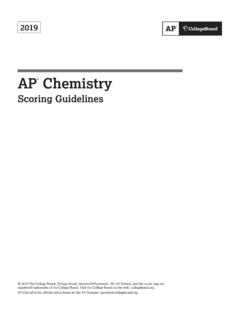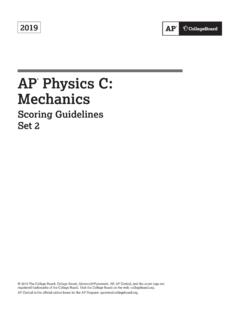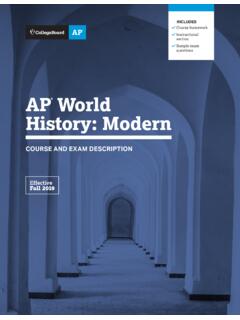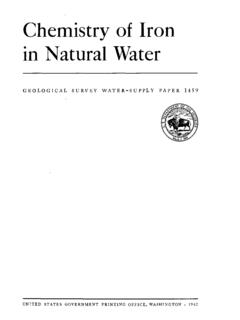Transcription of AP Chemistry 2019 Free-Response Questions
1 2019 AP ChemistryFree-Response Questions 2019 The College Board. College Board, Advanced Placement, AP, AP Central, and the acorn logo are registered trademarks of the College Board. Visit the College Board on the web: AP Central is the official online home for the AP Program: -2--3-AP Chemistry EQUATIONS AND CONSTANTS Throughout the exam the following symbols have the definitions specified unless otherwise noted. L, mL = liter(s), milliliter(s) g = gram(s) nm = nanometer(s) atm= atmosphere(s)mm Hg = millimeters of mercury J, kJ = joule(s), kilojoule(s) V =volt(s) mol=mole(s)ATOMIC STRUCTURE E = energy = frequency = wavelengthPlanck s constant, h = 10 34 Js Speed of light, c = 108 ms 1 Avogadro s number = 1023 mol 1 Electron charge, e = 1019 coulomb E = h c = EQUILIBRIUME quilibrium Constants Kc (molar concentrations)
2 Kp (gas pressures) Ka (weak acid) Kb (weak base) Kw (water) Kc = [C] [D][A] [B]cdab, where a A + b B R c C + d DKp = CDAB()()()()cdabPPPPKa = [H ][A ][HA] Kb = [OH ][HB ][B] Kw = [H+][OH ] = 10 14 at 25 C= Ka KbpH = log [H+] , pOH = log [OH ] 14 = pH + pOH pH = pKa + log[A ][HA] pKa = logKa, pKb = logKbKINETICS k = rate constant t = time t = half-life ln[A]t ln[A]0 = kt>@>@0AA11t = kt t = , LIQUIDS, AND SOLUTIONS P = pressure V = volume T = temperature n = number of moles m = massM = molar mass D = density KE = kinetic energy v = velocity A = absorbance a = molar absorptivity b = path length c = concentration Gas constant, R = J mol 1K 1= L atm mol 1K 1= L torr mol 1K 1 1 atm = 760 mm Hg = 760 torr STP = K and atm Ideal gas at STP = L mol 1PV = nRT PA = Ptotal XA, where XA =moles Atotal molesPtotal = PA + PB + PC +.
3 N = mMK = C + 273 D = mVKE per molecule = 12mv2 Molarity, M = moles of solute per liter of solution A = abc THERMODYNAMICS / ELECTROCHEMISTRYq = heatm = mass c = specific heat capacity T = temperature S = standard entropy H = standard enthalpy G = standard Gibbs free energy n = number of moles E = standard reduction potential I = current (amperes) q = charge (coulombs) t = time (seconds)Faraday s constant, = 96,485 coulombs per moleof electrons1 volt =1 joule1 coulombq = mc T S = productsreactantsSS DD H = productsreactantsffHHDD DD G = productsreactantsffGGDD DD G = H T S = RT lnK= n E I = qt2019 AP Chemistry Free-Response Questions GO ON TO THE NEXT PAGE.
4 -5- Chemistry Section II Time 1 hour and 45 minutes 7 Questions YOU MAY USE YOUR CALCULATOR FOR THIS SECTION. Directions: Questions 1 3 are long Free-Response Questions that require about 23 minutes each to answer and are worth 10 points each. Questions 4 7 are short Free-Response Questions that require about 9 minutes each to answer and are worth 4 points each. Write your response in the space provided following each question. Examples and equations may be included in your responses where appropriate. For calculations, clearly show the method used and the steps involved in arriving at your answers.
5 You must show your work to receive credit for your answer. Pay attention to significant figures. 1. The compound urea, H2 NCONH2, is widely used in chemical fertilizers. The complete Lewis electron-dotdiagram for the urea molecule is shown above.(a) Identify the hybridization of the valence orbitals of the carbon atom in the urea molecule.(b) Urea has a high solubility in water, due in part to its ability to form hydrogen bonds. A urea molecule andfour water molecules are represented in the box below. Draw ONE dashed line ( ---- ) to indicate a possiblelocation of a hydrogen bond between a water molecule and the urea (s) H2 NCONH2(aq)The dissolution of urea is represented by the equation above.
6 A student determines that grams ofH2 NCONH2 (molar mass g/mol) can dissolve in water to make mL of a saturated solution at 20. C. 2019 The College Board. Visit the College Board on the web: AP Chemistry Free-Response Questions GO ON TO THE NEXT PAGE. -6-(c) Calculate the concentration of urea, in mol/L, in the saturated solution at 20. C.(d) The student also determines that the concentration of urea in a saturated solution at 25 C is M. Basedon this information, is the dissolution of urea endothermic or exothermic? Justify your answer in terms ofLe Chatelier s principle.
7 (e) The equipment shown above is provided so that the student can determine the value of the molar heat ofsolution for urea. Knowing that the specific heat of the solution is J/(g C), list the specificmeasurements that are required to be made during the (J/(mol K))H2 NCONH2(s) H2 NCONH2(aq)?(f) The entropy change for the dissolution of urea, solnSD , is J/(mol K) at 25 C. Using the information inthe table above, calculate the absolute molar entropy, S , of aqueous urea.(g) Using particle-level reasoning, explain why solnSD is positive for the dissolution of urea in water.
8 (h) The student claims that S for the process contributes to the thermodynamic favorability of the dissolutionof urea at 25 C. Use the thermodynamic information above to support the student s claim. 2019 The College Board. Visit the College Board on the web: AP Chemistry Free-Response Questions GO ON TO THE NEXT PAGE. -7- 2. Answer the following Questions relating to the Chemistry of the halogens. (a) The molecular formulas of diatomic bromine, chlorine, fluorine, and iodine are written below. Circle the formula of the molecule that has the longest bond length.
9 Justify your choice in terms of atomic structure. Br2 Cl2 F2 I2 A Chemistry teacher wants to prepare Br2. The teacher has access to the following three reagents: NaBr(aq), Cl2(g), and I2(s). Half-Reaction E at 25 C (V) Br2 + 2 e 2 Br Cl2 + 2 e 2 Cl I2 + 2 e 2 I (b) Using the data in the table above, write the balanced equation for the thermodynamically favorable reaction that will produce Br2 when the teacher combines two of the reagents. Justify that the reaction is thermodynamically favorable by calculating the value of E for the reaction.
10 Br2 and Cl2 can react to form the compound BrCl. (c) The boiling point of Br2 is 332 K, whereas the boiling point of BrCl is 278 K. Explain this difference in boiling point in terms of all the intermolecular forces present between molecules of each substance. The compound BrCl can decompose into Br2 and Cl2, as represented by the balanced chemical equation below. 2 BrCl(g) Br2(g) + Cl2(g) H = kJ/molrxn A mole sample of pure BrCl(g) is placed in a previously evacuated, rigid L container at 298 K. Eventually the system reaches equilibrium according to the equation above.













![[CLASS XII CHEMISTRY PRACTICALS]](/cache/preview/8/e/c/c/7/0/2/b/thumb-8ecc702b441a6099d9810dbf9f2c3c2f.jpg)